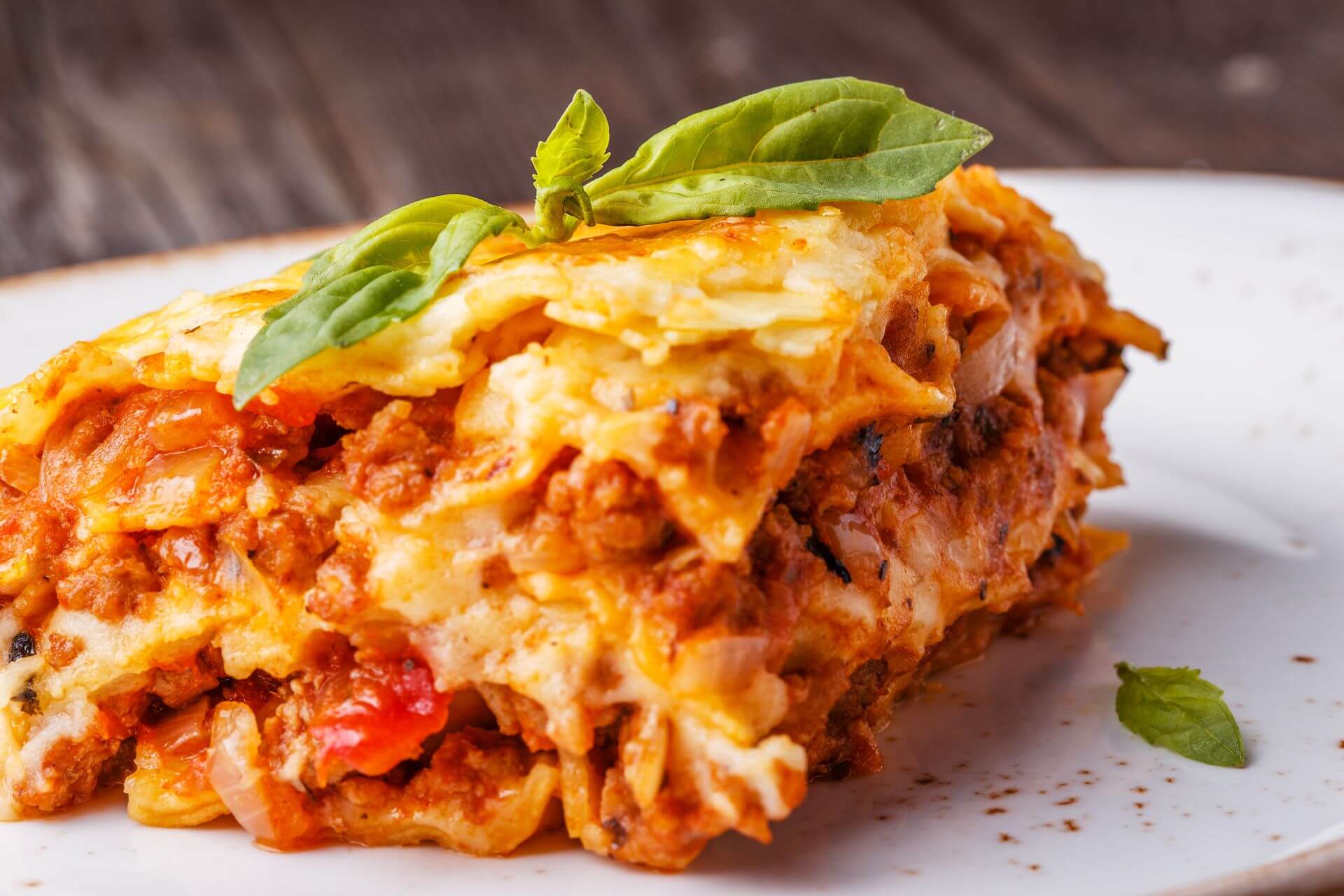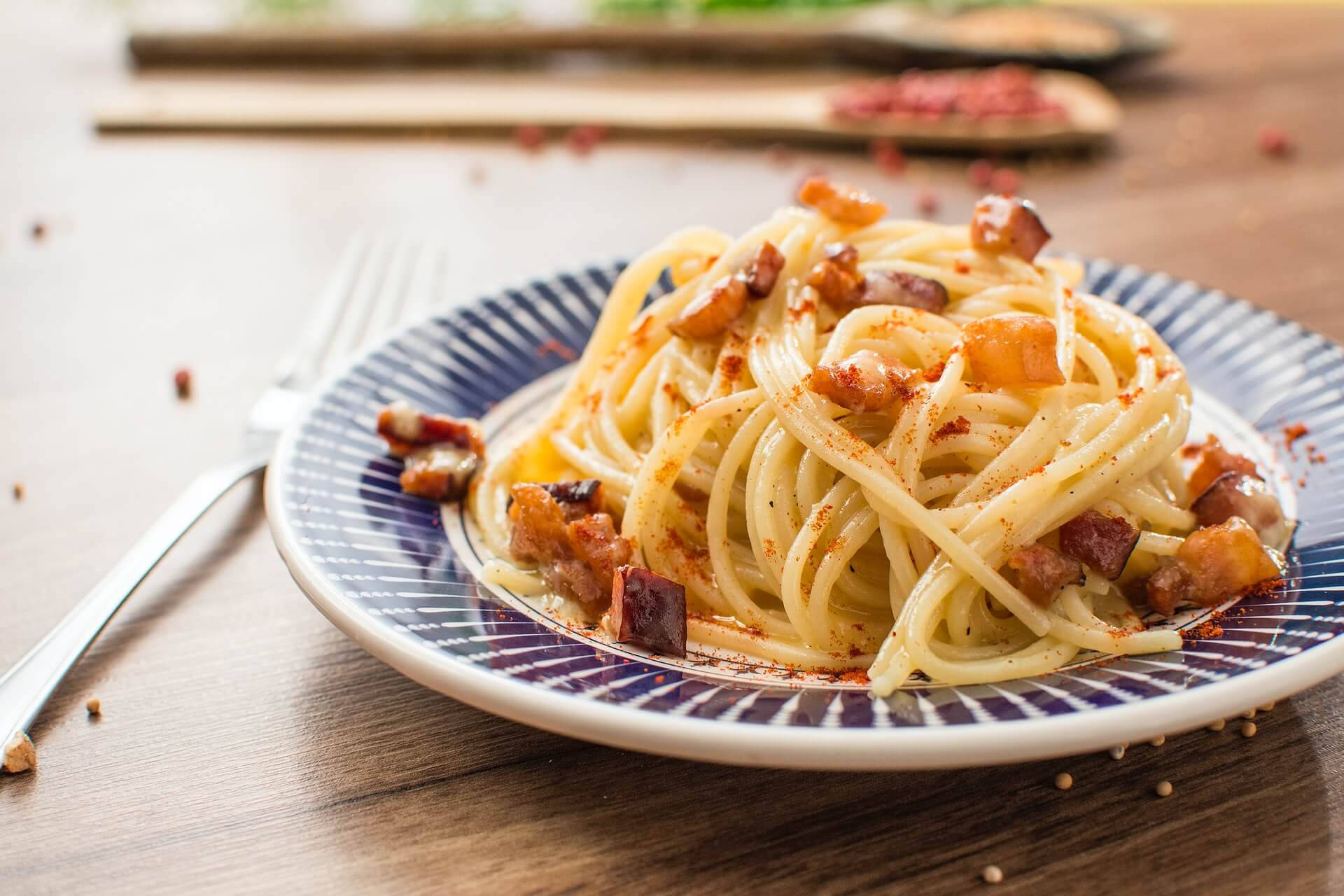Italian dishes are well-regarded for their delicious flavor combinations, elevating basic ingredients like pasta, olive oil, garlic, and tomato. These culinary delights have captivated food enthusiasts worldwide.
Exploring Italian cuisine offers a chance to connect with its rich heritage and traditions ingrained in daily life. From lasagna’s comforting embrace to the simplicity of spaghetti aglio e olio, the following ten dishes showcase timeless flavors worth savoring.
Related: 10 Classic Italian Drinks To Enjoy On Your Trip To Italy
***
Rome is one of the most popular travel destinations in the world. But at times, its countless tourist destinations and crowded visitor experiences can be somewhat overwhelming. That’s why I’ve crafted this gorgeously stylish Rome Destination Guide to spark your imagination and inspire your next adventure to The Eternal City.
1. Lasagna

No Italian food menu would be complete without Lasagna! This ubiquitous casserole is made with broad, flat pasta sheets and layered with fillings such as minced beef, vegetables, Italian seasonings, and various cheeses.
With archeological evidence dating early versions of Lasagna back to the 4th century, it’s not surprising that every Italian region has its own signature recipe. Some variations of this quintessential Italian comfort food include:
- Lasagne Napoletana from Naples which is usually only served during Carnevale, a holiday festival that takes place before Lent.
- Lasagne da Fornel, a meat and dairy-free variation from the Friuli Venezia Giulia that’s traditionally served on Christmas Eve.
But probably the most popular is the Lasagne Alla Bolognese. This classic dish uses ragù (slow-cooked meat sauce), béchamel sauce for a rich, creamy flavor and grated Parmigiano-Reggiano cheese.
You can enjoy an authentic Lasagna at some of the best Italian restaurants, such as Rome’s only 3 Michelin star holder, La Pergola in the Waldorf Astoria hotel and Palazzo Petrucci on the Gulf of Naples.
2. Deep-Fried Artichokes

Within Rome’s Jewish Ghetto, you’ll discover Carciofi alla Giudia, a renowned delicacy: Jewish-style fried artichokes with a centuries-old history dating back to the 16th century when the Roman Jews lived in the Ghetto until the 19th century.
This dish, a testament to the creativity of the Jewish community, shines as a pinnacle of artichoke preparations in Rome. It features the cimaroli artichoke, which lacks thorny leaves and a hairy central choke, making it easy to prepare.
Fried in golden olive oil, the artichoke transforms into a tender delight with crispy edges, offering a captivating mix of textures that invite you to savor every bite.
Unlike green artichokes, Carciofi alla Giudia is enjoyed whole, allowing you to experience the artichoke’s delicate essence harmonizing with the olive oil.
The dish’s flavor depth is extraordinary, a testament to generations of culinary expertise. It’s complemented by a side of aioli, enhancing the experience with its creamy, garlicky accompaniment.
This dish not only delights your taste buds but also honors the rich heritage and resilience of the Roman Jewish community.
3. Cacio e Pepe | Cheese & Pepper

Cacio e Pepe is a pasta dish that celebrates the enduring charm of “cheese and pepper.” With its roots in central Italy’s dialects, this dish offers rustic simplicity and profound flavors.
Its origins trace back to ancient Greek traditions, influenced by resourceful shepherds in the Italian Apennines. These shepherds carried sustenance: aged pecorino cheese, freshly ground pepper, and tonnarelli, a dried homemade pasta.
Cacio e Pepe remains a popular dish in Italy’s trattorias, with some using spaghetti instead of tonnarelli, but the original recipe’s essence endures.
Despite its humble composition, Cacio e Pepe exudes an elegance that belies its simplicity. Each bite of perfectly cooked pasta is coated in melted Pecorino cheese, its salty notes harmonizing with the robust heat of freshly ground pepper.
Cacio e Pepe has earned a place on the menus of renowned Rome establishments like Hosteria Grappolo d’oro.
To complement its flavors, consider a full-bodied white wine, offering a delightful contrast to the cheese’s saltiness and the pepper’s gentle heat.
4. Arancini | Risotto Balls

Rice is a culinary staple that connects various cultures and flavors worldwide, seen in dishes like Japanese donburi bowls, Spanish paella, and Italian risotto.
One example of regional rice cuisine is Italy’s Arancini, a popular street food dish. Its name, “little oranges” in Italian, alludes to its crispy, golden-brown exterior.
Arancini features tender rice infused with savory ingredients, coated in breadcrumbs, and deep-fried. The artistry of Arancini also lies in its diverse fillings, which range from classic meat sauce with peas to indulgent prosciutto, and include cheeses like mozzarella or pecorino. Vegetables like eggplant or tomatoes add freshness.
The result is a flavorful, texturally contrasting treat—a crispy exterior giving way to a creamy interior. Each bite is an explosion of flavors, embodying Italian street food culture, much like savoring a Croque Monsieur, leaving a lasting impression on the palate, a moment of culinary bliss.
Related: 10 Treats To Indulge in Paris
5. Pizza al Taglio | Pizza by the Slice

Picture strolling through Rome’s vibrant streets, enticed by the aroma of freshly baked treats. Amid the city’s hustle and bustle, you’ll see people relishing a culinary gem—Pizza al Taglio, an Italian tradition that celebrates indulgence, one slice at a time.
The name, “Pizza al Taglio” or “pizza by the slice” in Italian, perfectly encapsulates this culinary delight. Unlike the conventional round pies, it defies convention with its rectangular shape, baked to perfection in spacious trays. Its charm isn’t just in its form but its practicality.
Sold by weight, typically per kilogram or 100 grams, it allows you to enjoy precisely the amount that appeals to your taste, whether for a quick snack or to explore multiple flavors in one sitting.
Pizza al Taglio has earned its place as a culinary staple in the hearts of Romans and Italians across the country.
You’ll frequently see people walking the streets of Italy, clutching a square slice of Pizza al Taglio, savoring every bite that bursts with flavors and textures.
What makes it special is the pride of its makers in offering a variety of enticing toppings. When you step into a Pizza al Taglio shop, you’re welcomed by a range of fresh, seasonal vegetables, fragrant herbs, succulent meats, and rich cheeses.
You get to customize your slice, choosing the toppings that cater to your culinary desires.
6. Porchetta

Porchetta is a revered Italian delicacy cherished by locals and visitors for its captivating aromas and delightful flavors. The process begins with the careful deboning of a whole pig, leaving a blank canvas for a blend of spices and herbs.
Seasoning includes garlic, rosemary, fennel seeds, and black pepper, resulting in a harmonious flavor profile. The seasoned meat is then rolled meticulously to ensure a succulent, well-contained interior.
Slow roasting follows, requiring patience and adherence to tradition. The porchetta is gently cooked in the oven, infusing the air with its enticing aroma over hours.
Upon unveiling, the porchetta reveals a golden-brown, crispy skin contrasting with tender meat underneath. The first bite is a savory delight that leaves a lasting impression of culinary bliss.
Porchetta has a rich history dating back centuries, with legends even tying it to Emperor Nero’s fondness for this dish. Its heritage in central Italy endures as a testament to its timeless appeal.
Today, porchetta remains a celebratory centerpiece, gracing tables at public displays and festive occasions. It also finds favor with Italians and visitors when served by street vendors, especially within a Panino—an iconic Italian sandwich showcasing porchetta’s wonders.
8. Trapizzino
One of the latest things to hit the vibrant food scene in Rome, Trapizzino, was invented in 2005 by professional pizza maker Stefano Callegari.
Half-sandwich, half-pizza treat, a Trapizzino is essentially a white triangle-shaped pizza pocket closed on the sides and filled with a meat or vegetable secondo dish.
Initially, the filling revolved around traditional pizza toppings like beef, chicken, veggies and cheese. However, Trapizzino has expanded to include other classic Roman ingredients like seafood, chicken cacciatore, braised oxtail and Roman-style tripe.
Though it is the youngest Italian dish on this list, it’s no wonder Trapizzino has become an iconic Roman street food loved throughout Italy. Looking to enjoy this yummy dish. Look no further than a Stefano Callegari affiliated restaurant, Trapizzino Testaccio.
8. Gelato

A visit to Italy would be incomplete without savoring the creamy delights of gelato, readily available in the country’s numerous gelaterie, totaling over 37,000 in its charming cities and towns.
While both ice cream and gelato share a base of dairy and sugar, their distinctions lie in preparation. Gelato, staying true to its Italian heritage, relies more on milk and less on cream compared to ice cream. This balance results in lower milk fat content, allowing gelato’s vibrant flavors to shine with distinct clarity.
The world of gelato offers a wide array of flavors beyond the classic vanilla and chocolate. You can enjoy the nutty appeal of hazelnut, the blend of vanilla gelato with crunchy chocolate pieces in stracciatella, or the alluring notes of tiramisu, featuring coffee-drenched ladyfingers and velvety mascarpone.
Savor the rich earthiness of pistachio, the invigorating jolt of caffè, or the delightful combination of vanilla gelato swirled with sweet amarena cherries. Each spoonful of gelato invites you to explore the symphony of Italian culinary artistry.
Gelato’s distinctive character is also reflected in its presentation and serving temperature. Italian gelato is typically served slightly warmer, about 10–15°F higher than American-style ice cream, to ensure that your taste buds fully appreciate its nuanced flavors.
For the ultimate gelato experience, a visit to top gelaterie is a must. In Rome, Gelateria del Teatro and Come il Latte are popular choices. In Florence, La Carraia is alluring, and in Bologna, La Sorbetteria Castiglione stands out as a gelato destination.
These esteemed establishments take pride in crafting authentic gelato in-house, using natural ingredients and an artisanal, small-batch process to ensure the highest quality and authenticity.
9. Tiramisu

Tiramisu, whose name translates to “pick me up,” is a beloved dessert known worldwide for its delightful flavors and history of gracing our tables.
This dessert features layers of soft, cake-like Savoiardi (ladyfingers) soaked in aromatic espresso. These layers are then complemented by a velvety combination of Zabaglione, an Italian custard made from egg yolks, and mascarpone cheese known for its subtle creaminess. A sprinkle of cocoa adds a touch of bitterness to balance the sweetness.
While the classic recipe uses espresso, some variations incorporate liqueurs like dark rum or Marsala wine to enhance the flavor.
Tiramisu’s beauty lies in its simplicity; it doesn’t require baking. Instead, it’s an elegant assembly of ingredients that meld together over time. After careful layering, Tiramisu is left to rest in the refrigerator for a few hours, allowing the flavors to develop and reach their peak.
To enjoy Tiramisu, one can seek out establishments skilled in crafting this delectable dessert. In Rome, Residenza di Ripetta awaits, ready to enchant discerning taste buds with their world-class rendition of Tiramisu. In Florence, The Place Firenze stands as a beacon of culinary excellence, beckoning patrons to partake in the indulgence of their exquisite Tiramisu.
10. CARBONARA

Carbonara, a pasta dish originating from Rome, is a testament to the artistry of Roman cuisine. It combines eggs, cheese (Pecorino Romano, Parmigiano-Reggiano, or a blend), Guanciale (cured pork cheeks), and black pepper to create a creamy, flavorful delight.
The origins of Carbonara are subject to culinary lore. Some theories connect it to English and American troops during World War II who used available ingredients like eggs and canned bacon to create a satisfying dish. The name “carbonara” hints at its possible use by Italian charcoal workers.
Despite its uncertain beginnings, Carbonara is now firmly entrenched in Italian gastronomic tradition.
Top chefs worldwide have put their spin on Carbonara while respecting its core. These variations showcase their culinary creativity, adding new dimensions to this classic dish and surprising palates with delightful twists.
For an unforgettable Carbonara experience, discerning food enthusiasts are encouraged to reserve a table at Armando al Pantheon. Since 1961, this esteemed restaurant has delighted patrons with its exceptional rendition of Carbonara. Nestled just a stone’s throw away from the awe-inspiring Pantheon, this culinary gem offers not only an exquisite dining experience but also a glimpse into the rich history and charm of Rome.
Related: The Ultimate 3-Day Rome Itinerary
***
TRANSFORM YOUR TOURIST EXPERIENCE INTO A LOCAL EXPERIENCE
Italy is a country of remarkable beauty and enduring charm, offering a wealth of treasures to uncover. Amid the popular tourist attractions and bustling restaurants, there’s a world of authentic, personalized experiences waiting to be explored. These moments can turn a journey into a truly memorable adventure, allowing you to discover Italy’s magic in all its glory.
Picture a private gallery tour led by an expert who shares the secrets and stories behind each brushstroke, immersing you in the world of Italian art. Visualize exploring hidden gems, those lesser-known, enchanting corners where Italy’s soul unveils itself to the discerning traveler. Conclude your day with a culinary masterpiece at a Michelin-starred restaurant.
Yet, these exceptional experiences often remain exclusive and hard to access for many travelers. That’s where my role as an experienced travel advisor becomes invaluable. I simplify the planning process and help you navigate the complexities of entry requirements. What’s more, I curate authentic encounters tailored to your preferences.
Embrace a new kind of luxury, one that focuses on full immersion in your travel destination. If you seek a journey that goes beyond the ordinary, I encourage you to take the first step.
. Click here to request a complimentary consultation with me. It’s your time to uncover the hidden treasures of Italy (or any other destination) and create memories that will forever reside in the depths of your soul.

